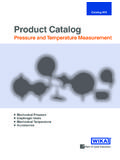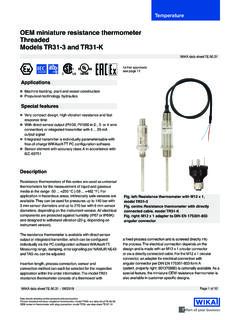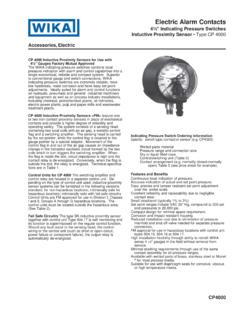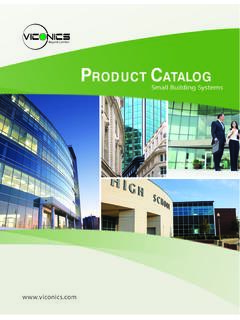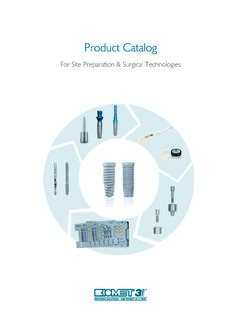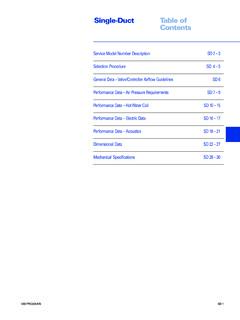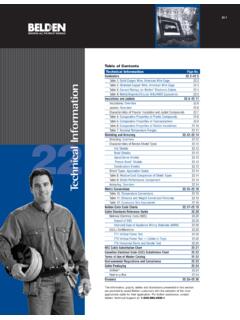Transcription of Product Catalog - WIKA
1 Mechanical Pressure Diaphragm Seals Mechanical Temperature AccessoriesProduct Catalog Pressure and Temperature MeasurementCatalog 900 RProduct Catalog 900 Mechanical Pressure Diaphragm SealsMechanical TemperatureAccessoriesPrinted in the United States of AmericaProduct Catalog 900 Pressure and Temperature Measurement is a registered trademark of Underwriter's Laboratories. is a registered trademark of Underwriter's is a registered trademark of WIKA Instrument is a registered trademark of the Halocarbon Products Corporation. Hastelloy is a registered trademark of the Cabot family of companies. Fluorolube is a registered trademark of the Hooker Chemical & Plastics Corporation. Monel and Inconel are registered trademarks of the INCO family of companies. Viton & Teflon are registered trademarks of the DuPont family of TEMPERATURE Bimetal Thermometers Operating Principle 126 General Specifications 128 132 134 Ordering Bimetal Thermometers 135 Bimetal Thermometer Options 137 Digital Thermometers 138 Twin-Temp Thermometers 139 143 Gas Actuated Thermometers 148 Vapor Actuated Thermometers 150 Industrial Glass Thermometers 152 152 153 Thermowells / TW15 (Threaded) 159 / TW10 (Flanged) / TW20 (Socket/Weld) 160 / TW30 (Sanitary)
2 161 Industrial Glass 162 ACCESSORIES Gauge Cocks Needle Valves Mini-Needle Valves Block & Bleed Valves Multi-Port Valves Snubbers Overpressure Protectors Test Port Plug Adaptors 170 Couplings Mini-Siphon Siphons 172CP3000/CP4000 Alarm Contacts 173 Socket Restrictor 176 Drag Pointer 176 Alarm Contacts 176 Pressure Gauge Accessories 177 Standard Dial Layouts 182 Conversion Chart 184 Cross reference Chart IBCS electing a Pressure Gauge 2 Chemical Compatibility table 3 Advantages of Liquid-filled Gauges 4 WIKA Type Numbers 5 Ordering Guidelines for Pressure Gauges 6 MECHANICAL PRESSUREC ommercial Gauges 1 ", 2", 2 ", 4" - Fire Sprinkler 4" 1 ", 2", 2 " 1 , 2 , 2 , 4 1 ", 2" 4 " 13 1 ", 2 " 1 15 Industrial & Process Gauges 1 ", 2" 4" 10" 6" 2 ", 4" 3 " 2", 2 ", 4" 2", 2 ", 4" 4" 2 , 4" 2 " 2 ", 4" 2 ", 4", 4 ", 6" 4 " 4 " 4 ", 6" 4 " 4 " 4 ", 6" 4 ", 6" 4", 6" 4", 6" 44 Low Pressure Gauges A2G-10 45A2G-15 2 " 4" 4 " 4" 50 Differential & Duplex 2 ", 4 " 2 ", 4 " 6" 4 ", 6" 4 ", 6" 4 ", 6" 4 ", 6" 57 High Precision Gauges 6" 6" 4" 4 " 4 / 4 10 64 Calibration EquipmentCPH-6600 65 CPG 1000 66 WICP-L100, WICP-M500.
3 WICP-H10K 67 DIAPHRAGM SEALS Diaphragm Seal Applications 69 Operating Principle 70 Selection Guidelines 71 Assembled Seals 78 Threaded Seals 89 Flanged Seals 96 106 Sanitary Seals 108 Plastic Seals 109 InLine Seals 110 115 Seal 117 General Seal Information 119 Product Catalog > table of Contents table of ContentsFor complete detailed information, including electronic pressure, electronic temperature and ultra high purity products, please visit selecting a pressure gauge, it is important to consider the following factors to ensure safety and accuracy:1.
4 Pr essure fluid composition2. Pr essure fluid temperature3. Ambient conditions4. Pr essure range5. Conditions affecting wear of the system6. Method of mounting7. R equired accuracy1. Pr essure fluid composition Since the sensing element of a pressure gauge may be exposed directly to the measured medium, consider the char acteristics of this medium. It may be corrosive, it may solidify at various temperatures or it may contain solids that will leave deposits inside the sensing element. For pressure fluids that will not solidify under normal conditions or leave deposits, a Bourdon tube gauge is acceptable. Otherwise a Sealgauge or diaphragm seal should be used. A chemical compatibility chart follows this section to aid in the selection of the proper sensing element Pr essure fluid temperature Steam and other hot media may raise the temperature of the gauge components above safe working limits of the sealed joints.
5 In these cases it is recommended that a siphon, cooling tower or diaphragm seal be used in conjunction with the pressure Ambient conditions The normal ambient temperature range for WIKA pressure gauges is -40oF to +140oF (-40oC to +60oC) for dry or silicone-filled gauges and -4oF to +140oF (-20oC to +60oC) for glycerine-filled gauges. The error caused by temperature changes is + or per 18oF rise or fall, respectively. The reference temperature is 70oF (20oC). The correction is for the temperature of the gauge, not the temperature of the measured medium. R emote gauge mounting using a diaphragm seal and capillary line is one alternative for applications involving e xtreme ambient temperature. Moisture and weather effects must also be considered. Liquid-filled gauges prevent condensation build up. F or outdoor use, stainless steel, brass or plastic cased gauges are Pressure range A gauge range of twice the working pressure is generally selected.
6 The working pressure in all cases should be limited to 75% of the gauge range. Where alternating pressure and pulsation are encountered, working pressure should be limited to 2/3 of the gauge Conditions affecting wear of the system In applications involving severe pressure fluctuation or pulsation, the use of restrictors and/or snubbers is recom- mended. In addition, liquid-filled gauges increase the service life of gauges in these conditions. WIKA liquid- filled gauges are generally filled with glycerine. Silicone for larger temperature extremes and Halocarbon for use with oxidizing agents such as chlorine, oxygen and hydrogen peroxide are also Method of mounting R adial (LM) and back (CBM or LBM) connections are available for most WIKA gauges. WIKA stocks gauges with standard NPT threaded connections. Other types such as metric threads, straight threads, hose barbs and special fittings are available as a special order.
7 Pr essure gauges should be mounted in the upright position. For applications where the gauge is mounted side w ays, horizontally or upside down, contact WIKA Customer Service for gauge type Required accuracy WIKA stocks gauges with accuracies from 3/2/3% to of span (ASME Grade B to Grade 4A). To ensure safe and accurate gauge selection, you must take all of the above factors into consideration. When in doubt, please do not hesitate to contact your local stocking distributor or WIKA Customer Care for assistance! 1-888-WIKA-USAP roduct Catalog > Selecting a Pressure Gauge Selecting a Pressure Gauge3 NOTE: For steam service, a siphon is the process fluid in the table above and match the letter code (A,B,C, or D) with the wetted part material listed below: A = Brass (Copper Alloy) B = 316 SS C = Monel D = Consult Factory This table is provided as a reference only and is accurate to the best of WIKA's knowledge.
8 WIKA assumes no responsibility for, or obligation from, the information here. Product Catalog > Chemical Compatibility Chart Chemical Compatibility ChartAcetic Acid B Ethyl Acetate A Oxygen AAcetic Anhydride D Ethyl Cellulose B Paraffin AAcetone B Ethylene A Phosphoric Acid BAcetylene B Ethylene Dibromide B Photographic Solutions BAlcohol A Ethylene Dichloride D Pickling Solutions BAlums B Ethylene Glycol A Picric Acid BAluminum Sulfate B Ferric Nitrate B Picric Acid (dry) BAmmonia B Ferric Sulfate B Potassium Chloride DAmmonium Carbonate B Formaldehyde B Potassium Cyanide BAmmonium Hydroxide D Freon A Potassium Permanganate BAmmonium Phosphate D Gallic Acid B Prestone ABeer A Gas (for lighting) A Salicylic Acid ABenzine A Gasoline A Sea Water CBenzol A Gasoline (refined) B Silver Nitrate BBenzyl Alcohol B Glucose C Sodium Carbonate DBleach Liquors B Glycerine A Sodium Cyanide DBordeaux Mixture A Hydrocyanic Acid B Sodium Hydroxide DButane B Hydrogen B Sodium Nitrate BButanol A Hydrogen Peroxide B Sodium Peroxide BButyric Acid B Kerosene A Sodium Phosphate BCalcium Bisulfite B Lacquers A Sodium Sulfate BCalcium Chloride C Lactic Acid B Sodium Sulfide DCalcium Hydroxide B Lysol B Sodium Sulfite BCarbon Dioxide(dry) B Magnesium Hydroxide C Sulfur Dioxide DCarbon Bisulfide B Magnesium Sulfate B Sulfur Dioxide (dry) BCasein B Mercury B Sulfuric (75%) BChloroform B Methyl Chloride D Sulfurous Acid BChromic Acid B Methyl Salicylate D Tanning Liquors DCitric Acid B Naphtha A Toluene ACoal Gas A Nickel Acetate B Vegetable Oils BCopper Sulfate B Nitric Acid (pure) B Vinegar BCottonseed Oil B Nitrous Acid D Water ACreosote (crude) B Nitrous Oxide D Whiskey BDextrine A Oil (lubricating)
9 A Wines BEthers D Oil (refined) A Zinc Sulfate B4 Liquid-filled gaugesLiquid-filled pressure gauges provide a number of advantages: the liquid absorbs vibration and pressure spikes the dampening action of the liquid enables the operator to take readings during conditions of rapid dynamic loading and vibration the liquid lubricates all moving elements, dramatically reducing wear in the movement because most liquid-filled gauges are filled with non-aqueous liquid and hermetically sealed, they perform in corrosive envi-ronments and are immune to moisture penetration and icing, and shock effects are lessenedLiquid-filled gauges enhance the reliability and integrity of the measuring system for long periods under extreme operating the Right LiquidThe type of liquid used to fill the gauge varies with the appli-cation. Although pure glycerine provides the best perfor-mance in most applications, each has its own requirements. Guidelines to help ensure that a fluid is properly matched to an application are: if icing is a problem, use gauges filled with silicone oil or other comparable liquids.
10 They have low viscosities e ven at -60oC if the s ystem has electric accessories, such as contacts , use insulating oils, and if e xtreme temperature fluctuations are expected, use silicone oilsThe higher the liquid viscosity, the greater its dampening capacity. The reason for this is that dampening changes in proportion to the temperature-dependent viscosity of the filling liquid. The suitable degree of dampening depends on the operating requirements the gauge must meet, such as pointer response time, pressure extremes, vibration and changes in pressure. WIKA can recommend specific liquids to suit problem : Some parts of the pressure gauge may not be able to withstand temperatures above 140oF. Consult with the factory for technical assistance for these Fill Fluid Ambient Temperature Ratings ( table A)Allowable Operating Range - Temperature range in which the operation of the gauge is not adversely affected by the filling liquid.
